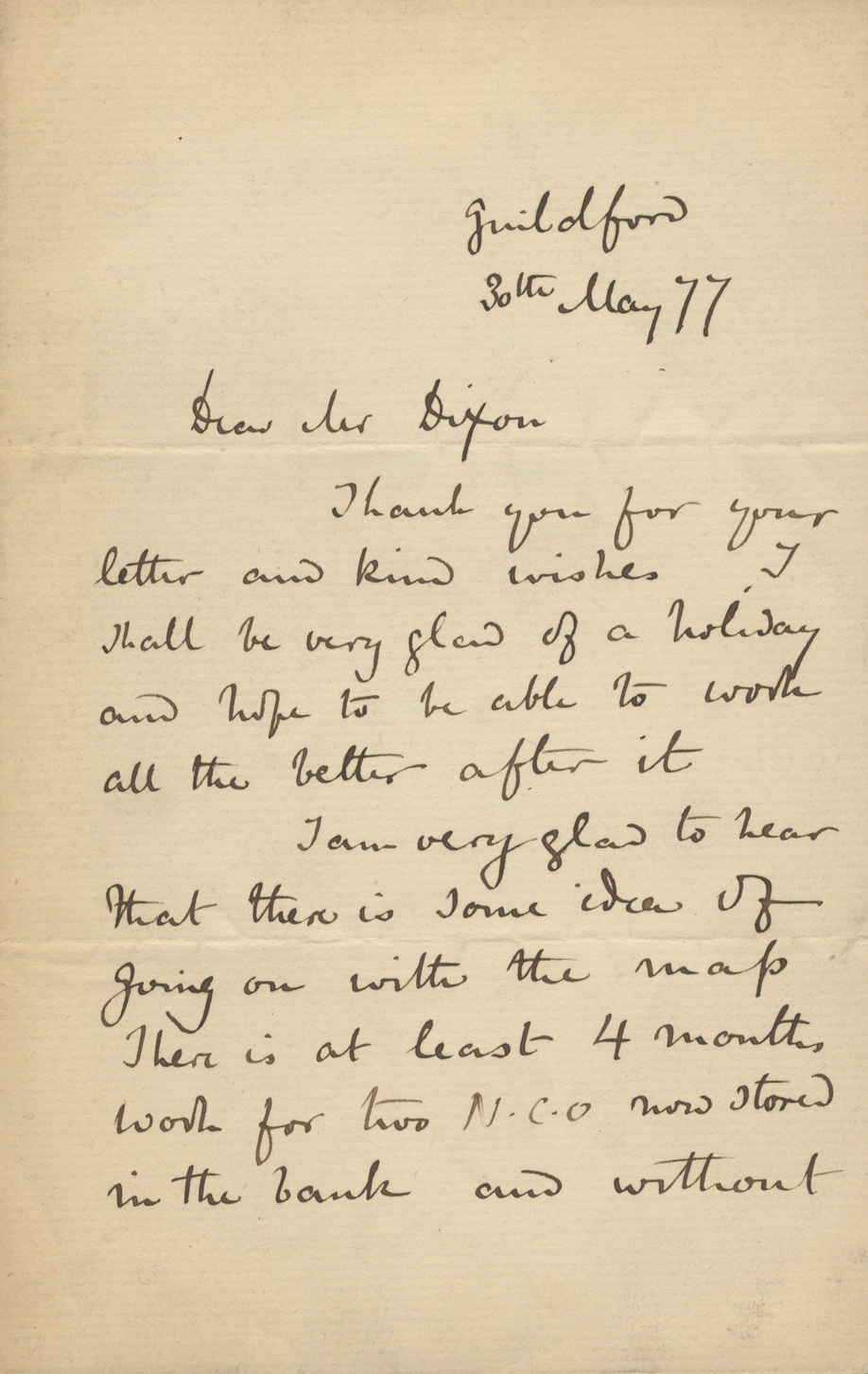Claude R. Conder
Claude R. Conder
Claude R. Conder Jack the Ripper Autograph Letter Signed - 1877
Autograph Letter Signed dated 1877 by British soldier, biblical archeologist, surveyor—and Jack the Ripper suspect—Claude R. Conder, to William H. Dixon, fellow member of the Royal Geographic Society. Interesting historical content regarding the mapping of Jerusalem and Lord Kitchener’s progress. Two single-side pages each 4.5″ x 7″, penned in dark brown fountain ink on cream-colored laid stationery. Excellent condition. In full:
Guildford
30th May 1877
Dear Mr. Dixon
Thank you for your letter and kind wishes. I shall be very glad of a holiday and hope to be able to work all the better after it.
I am very glad to hear that there is some idea of going on with the map. There is at least 4 months work for two NCO now stored in the bank and without counting what Kitchener brings home.
I am sorry to see in The Standard that there has been a Panic in Jerusalem.
Kitchener is going rather slow only half my rate of progress but this is due to the man being new to the work & his triangulation seems very good.Yours truly
Claude R. Conder
Claude Reignier Conder (1848-1910) was a British soldier, engineer, biblical archaeologist and member of the Royal Geographical Society. Educated at University College London and the Royal Military Academy, Woolwich, Conder became a lieutenant in the Corps of Royal Engineers at age 22 and went on to enjoy a distinguished career, potentially marred only by one recent suspicion—that he was England’s infamous serial killer Jack the Ripper.
Commissioned by Britain’s Palestine Exploration Fund (PEF), in 1872 Conder began extensive survey work in Palestine, and in 1874 was joined by fellow Royal Engineer Horatio Herbert Kitchener to carry out a mapping survey of the Holy Land. Between 1874 and 1877 Conder and Kitchener surveyed what is today Israel, the West Bank, and Gaza. The results of their expedition were published in 1883 by the PEF, among eight volumes known as the Survey of Western Palestine, still in use today as the basis for the grid system used in modern maps of Israel and Palestine.
In another volume of the Survey of Western Palestine, Conder and fellow school chum Sir Charles Warren gained worldwide fame by writing of their excavations of hundreds of sites in the Middle East between 1867 and 1882. Significantly, they also discovered the remains of King Solomon’s Temple in Jerusalem, from which Conder recovered a number of artifacts and rings he brought back home to London.
Conder’s correspondent in this letter, William Hepworth Dixon, was also a fellow of the Royal Geographical Society. In 1865 he published The Holy Land, a picturesque handbook to Palestine relevant, of course, to Conder’s interests.
COULD CLAUDE CONDER HAVE BEEN JACK THE RIPPER?

Apart from the significant accomplishments of a decorated British soldier who has earned an illustrious place in British history, Conder’s name has recently been put forward as a suspect in London’s notorious Jack the Ripper murders.
“Jack the Ripper” is the best-known name given to an unidentified serial killer who was active in the largely impoverished areas in and around the Whitechapel district of London in 1888. Attacks ascribed to the Ripper typically involved female prostitutes who lived and worked in the slums of London and whose throats were cut prior to abdominal mutilations.
There is no evidence that Claude Conder was suspected of being Jack the Ripper at the time of the murders, but according to recent research revealed by crime writer Tom Slemen and criminologist Keith Andrews, the authors of “Jack the Ripper – Secret Service” are convinced that Conder, then a 39-year old British intelligence officer, archaeologist, writer, map-maker and allegedly trained killer—fluent in Arabic as well as Yiddish and a number of European languages—was indeed Jack the Ripper.
The authors advance a persuasive set of theories:
- That Sir Charles Warren, the head of the London Metropolis Police and a close friend of Conder, knew he was the Ripper, but kept quiet and took the secret with him to the grave;
- That artifacts and rings excavated by Conder and Warren from King Solomon’s temple in Jerusalem were stolen from Conder’s home by Ripper victim Annie Chapman;
- That all of the Ripper victims knew each other and had all benefited from the stolen goods;
- That Conder left cryptic messages carved on his victims bodies; and
- That the “Goulston Street message,” a possible clue in the murders, was written in an ancient language that Conder knew from working in the Middle East—and which his friend Charles Warren had immediately removed from the wall on which it had been written.
As compelling as this may be for “Ripperologists” and others with an interest in unsolved mysteries, keep in mind there have been well over 30 suspects, including a few notables, among them:
- Lewis Carroll, the author of Alice in Wonderland
- Prince Albert Victor, Queen Victoria’s grandson
- William Withey Gull, Queen Victoria’s personal physician
In any event, this is a hard-to-find letter of historical relevance to the Holy Land and one of history’s more intriguing individuals.

